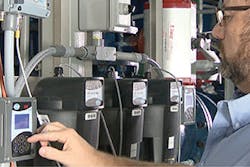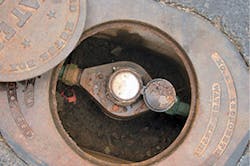IMAGINE A CITY that uses its own real-time data to solve real problems. These concepts of smart cities and the Internet of Things (IoT) have become increasingly more mainstream and are no longer a futuristic idea. Yet many municipalities may not know where to begin or if IoT-driven initiatives are financially feasible to take on. A smart, sustainable, advanced metering strategy for water and other utilities can be a great starting point, and these projects are more within reach than many states, cities, and towns might assume. Smart water infrastructure projects like this are an opportunity to use technology and data to capture lost revenue, improve sustainability and efficiency, and offer a higher quality of service to residents.
DEFINING A SMARTER APPROACH TO WATER EFFICIENCY
A smart city is future-ready, connected, and sustainable, turning data into improved operations for the municipality and better quality of life for residents. A city’s entire infrastructure can be the backbone and physical framework for the connected technologies for smart city strategy, and as such, smart metering for water and other utilities is a chance to take steps toward a more connected municipality overall.
Smart water metering means that networked, centralized water and wastewater systems leverage data from connected technologies to improve overall operations. Public works departments can use the data to pinpoint existing and potential leaks, compare year-over-year consumption levels, track customer payments, and provide information on how water usage varies by type of business or size of home. This not only streamlines management in the moment, but helps municipal leaders define priorities for the future as it relates to sustainability, infrastructure maintenance, overall system performance, and more.
Making a smart meter upgrade a reality does not have to be financially out of reach. For municipalities that enter into Energy Performance Contracts and contingent payment programs, projects are designed so that operational and energy savings uncovered by the upgrade are equal to or greater than the cost of the project itself. This offsets the initial investment and has a neutral impact on the customer’s budget over the course of the implementation. Another alternative funding option is a public-private partnership, which transfers the risk of the project to the private sector in exchange for guaranteed service and fixed payment terms over a determined period. With alternative funding methods like these, municipalities can upgrade infrastructure to improve operations without raising or creating new taxes for residents.
CAPTURING LOST REVENUE WITH LEAK DETECTION TECHNOLOGY
Across the US, it’s estimated that about 6 billion gallons of water are lost due to leaks each day. Leak detection systems are a critically important element for capturing lost revenue and determining opportunities to reduce wasted resources.
With daily monitoring of city-wide water distribution, departments of public works can gain valuable insight into unseen issues. A smart leak detection system uses acoustic signatures to detect potential leaks, using sensors mounted on customer service lines upstream of water meters. The sensors pick up on vibrations caused by leakages, recording the data and uploading it to a proprietary website to be analyzed. The data is next used to map potential leaks and suggest priorities for maintenance based on the severity of leaks throughout the city. By exporting this information into a work order management system, DPW employees can head out to fix the issues, using noise correlators to locate the leaks that are causing the largest loss of resources.
This approach not only reduces lost water but helps to limit any damage to surrounding buildings and roads that would result from these leaks going undetected. Water department employees would have the opportunity to stay a few steps ahead of potentially avoidable water damage, such as sinkholes or damaged infrastructure.
In smart cities, data from connected technologies can be used to improve operations.
EMPOWERING PUBLIC WORKS DEPARTMENTS WITH CRITICAL INFORMATION
With technologies like leak detection and centrally managed systems, public works departments are armed with the information necessary to define needs and strategize for a more efficient approach to water management in the future. For example, in addition to providing data on water usage and locating leaks, reporting can give insight to water resource recovery facilities to tailor operations and define needs based on real-time information. This can range from actual running capacity versus the facility’s design capacity, the remaining life of assets, spending on unplanned maintenance, status of facility security, and average daily energy spent.
With these reporting capabilities, the need for human supervision and management of equipment in water resource recovery facilities is reduced. When paired with work order and maintenance management systems, departments can optimize labor across the board by freeing up employees to focus on other pressing priorities.
This clear, actionable information about the various maintenance needs or leakage issues across water operations allows departments to quickly prioritize and schedule maintenance to proactively mitigate any issues that might result in costly overtime for the department. Without insight into operational issues or maintenance needs, problems that go undetected can also result in urgent repairs that disrupt traffic flow, safety, and water service to customers.
IMPROVING SERVICES FOR RESIDENTS
Most people don’t interact much with their local department of public works, but the data provided by smart metering allows municipalities to improve customer service by more proactively delivering relevant information and efficiencies to residents and business owners. Imagine having your city send out a technician for a proactive maintenance check, or receiving a call to alert you to a potentially costly issue based on trends in your recent water usage. Both scenarios are possible if your town has a smart metering strategy.
The advanced metering infrastructure (AMI) installed during a smart meter upgrade helps ensure a more accurate meter reading over the life of equipment and captures incremental data on the water activity of each customer. This allows for daily reports that track consumption among the customers using the most water within the city. In the event of an unusual decline or increase in reported water usage, a technician can be sent out to determine the source of the problem and fix it before any issues become very costly for the customer.
Smart water technologies can drive efficiencies and sustainability for home and business owners by providing a platform for smart controls across other building systems. By optimizing HVAC controls to the ideal start and stop times for water heating, a customer’s water can be heated right before it is required. This guarantees the availability of a hot water supply while lowering energy costs. Departments of public works can also leverage data from automatic alerts about leakage to proactively check-in with home and business owners about probable leaks or issues, which can save hundreds of dollars in excessive water use and help prevent costly water damage.
Flood detection is another important example of how a smart water strategy can improve city services for residents. Especially in flood-prone areas, it is essential to provide proactive communication to drivers and residents about potentially flooded roadways. Connected LED streetlighting can be networked with sensors and video surveillance to detect floods and other real-time events, such as a water main break. This is a critical asset for channeling important information to city managers and initiating mass communication systems to keep residents safer—it’s also a perfect example of how to take existing physical infrastructure far beyond its most basic purpose to work toward a safer city.
From capturing lost revenue and saving resources to delivering more proactive services to residents, departments of public works can improve operations and stay future-ready with a smart water strategy, taking a foundational step toward a smarter, more sustainable municipality.


